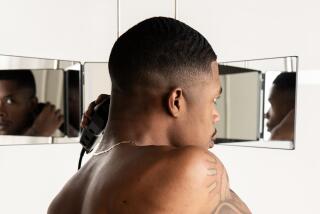There’s Simply No Untangling This Hair Fetish Women Have
- Share via
We were gossiping about I can’t remember what and I can’t remember why, when my friend unsheathed her dagger. “A Breck girl,” she called the object of her scorn. She almost hissed as she said those words.
The Breck girl really wasn’t one in an official sense, or at least not as far as we knew, but it didn’t matter. This woman had hair , beautiful reddish hair, sort of long, with a bit of a wave. Perfect hair.
We hated her for it.
Naturally, we would have killed to have been so maligned ourselves. But there was no danger of that.
If I were in analysis, maybe this would be something that I would need to work out. And, clearly, it would be a group session.
Women have this thing about their hair.
It is dark and frivolous, this thing--scary, politically incorrect. It is the kind of thing that will lead professional women--educated, aware women--to linger in the bathroom at the office to discuss the merits of Diane Sawyer’s new cut or that awful clump near her forehead that Jane Pauley is finally growing out.
“My God, somebody should tell her.”
“Somebody apparently did.”
I don’t know who it was that first declared a woman’s “crowning glory” to be her hair, but I’m betting it was a man. This hair fetish has got all the signs of yet another male plot. How come nobody ever calls a balding woman “cute”?
And no way are prominent women, the serious take-charge type, immune from the lunacy. They complain that their ideas have been known to take second billing to their hair. I remember Diane Sawyer was saying this not long ago. She sounded appalled.
(I know, Diane, this hair thing is a sickness. It belittles women, it’s bubble-headed. And I’ve since come around; I like your shorter look now!)
So, anyway, when I heard that the Dial Corp. was calling all “Breck girls,” I was intrigued. These “girls” (the oldest on the far side of 80 now), were featured in ads for Breck shampoo from the 1930s through the mid-70s.
“Back then, being called a Breck Girl was one of the highest compliments a female could receive,” says a Dial brochure trumpeting its “Breck Girl Hall of Fame” exhibit at the company headquarters in Phoenix.
The company says there were about 300 Breck girls in all; it’s tracked down about half of those to date. (Among the well-known Breckies: Kim Basinger, Cybill Shepherd, Brooke Shields, Jaclyn Smith, Christie Brinkley, Cheryl Tiegs, Erin Gray).
Dial bought Breck two years ago, after the Brecks sold the once-premier shampoo line and it promptly went declasse. (Needless to say, Dial says the new Breck shampoo is great.)
A company spokeswoman--who, incidentally, confirms that Breck founder John Breck got together with a chemist friend to invent the stuff when he was going bald--says the Breck girl search is going “very, very well.”
“I have never seen anything like it,” she says. “The response to this has been absolutely incredible.”
Indeed.
So naturally I called a couple of Breck girls to see where they stood on the important issues of our times. Like hair, for one.
Former model Willi Koopman (Breck girl, 1965) exuded an uncommon confidence in the stuff growing from her scalp. She will be 48 this month and has a floral design and antique business in Woodland Hills. Her hair used to be light brown. It’s a few shades lighter now.
“I have always liked my hair,” Willi says. “It’s the traditional look, the page boy look. It’s always been clean.”
Willi says women would often ask her for advice on how she pulled off her look. (Tip: “I used to use beer in my hair, instead of hair spray, on the ends. It would add a lot of body to it.”)
Then I called Elizabeth Campbell Tryens. Elizabeth lives in a trailer park in Hemet. She sounded about 20, but in fact she will be 80 in a couple months. She laments that she can’t find a tennis partner.
Elizabeth was a Breck girl in 1955, when she was in her 40s. Back in Springfield, Mass., she was a neighbor to artist Charles Sheldon and later worked for him at the advertising company that had the Breck account.
(Elizabeth went on to become a supervisor at Glemby International, another big player in the Hair Conspiracy worldwide.)
“I don’t think we dwelled on being Breck girls,” she says. “I don’t think there was an airhead among us.”
Elizabeth, who always wore her light brown hair short, says the style then was tighter, more close in, more controlled. But now that she knows better, Elizabeth says she prefers the wild look.
“If I had to live over again, I’d have a great big bushel basket of hair,” she says. “I love the ads today where they toss the hair around and it swings. It’s free.”
Then Elizabeth sort of jumps off from there.
“You know how women are,” she goes on. “You look in the mirror and you see if there are any new wrinkles, any pimples. Well, I don’t look for any of that anymore. I look in there and say, ‘Well, old girl, you are not doing too badly!’ You can’t reach 80 and not think like that.”
Finally, Elizabeth makes a prediction. And, frankly, I was on the edge of my seat waiting to hear. She says that based on her own experience, she can assure me that my life will be great.
But then I realized that Elizabeth hadn’t even seen my hair.
Dianne Klein’s column appears Sundays in View.






